Foundation for Rural & Regional Renewal (FRRR)
The work of the Wardell Community Organised Resilience Effort (CORE) is an example of how a small town can rally in the face of a natural disaster and be ready for disasters to come. Most days, Wardell is an idyllic spot to live. Lush, green and quiet on the banks of the Richmond River in the Northern Rivers region of NSW. But in 2022, floods devastated the town and others nearby. Wardell had never flooded before, and no one was prepared.
Wardell CORE was set up as a resource centre for emergency donations. Bedding, blankets, clothes, food, medical supplies, water, torches, batteries and tents were all gratefully received. The need was immense. Two years on, Wardell CORE’s primary purpose is still helping affected people. Some are still homeless and many struggle with mental health issues, including PTSD. Their other main aim is to make sure the community is never impacted in the same way again.
Planning for the way forward
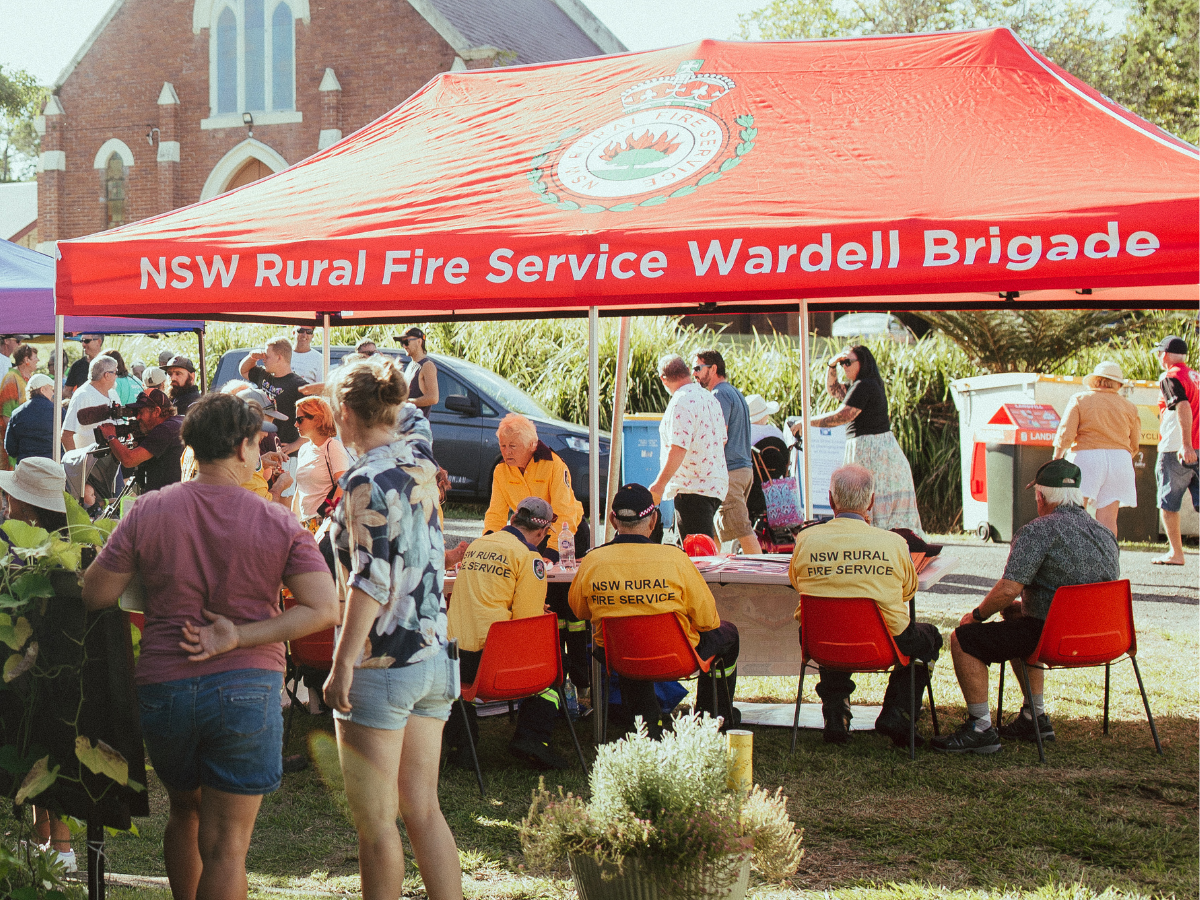
During the 2022 floods, mobile and internet telecommunications were impacted, meaning Wardell and the surrounding communities had limited or no communication in many areas until power could be restored or services fixed. Having no communications during a disaster created all kinds of problems – the emergency services people couldn’t share vital information, residents were cut off from family and friends, and there were any number of complexities around ongoing recovery.
After the flood receded, Wardell CORE immediately started planning for the next one, and detailed planning identified a need for a way for the community to stay informed, given the power outage lasted for two weeks or more. CB radio was the solution. They received a $10,000 grant from FRRR through Telstra’s Connected Communities program that funded the purchase of 10 hand-held devices and two base stations, as well as funds left over to support the community with the appropriate training. Through additional fundraising, they were able to install a relay station that helps to extend the signal as far as possible to provide radio reception throughout town and with the nearby communities of Woodburn and Coraki up-river, and Ballina down-river.
Where to next?
The organisation plans to distribute more radios throughout the region to anticipate flood events as widely and comprehensively as possible. Another resilience move they made was installing a Starlink service that uses a network of satellites to provide internet coverage, and installing onsite battery storage so that they will have internet in the event of future power outages.
The team behind Wardell CORE recognises that locals in the region experience high levels of anxiety about weather events, but the low level of digital literacy in the community is a real barrier to disaster preparedness. To resolve this, they’re looking at establishing a program that teaches people how to access and interpret weather apps and other related platforms.
A spokesperson for Wardell CORE explained the impact of the grant they received.
“Without the FRRR grant from Telstra’s Connected Communities program, we would never have been able to put our disaster preparation plans into action. The lessons learned from the 2022 floods meant we knew what technology we needed and where it should be located. But our reliance on small donations meant we could never have afforded it. Now we have the communications we need to feel confident about our ability to protect our people, physically and mentally, from any flood events in the future.”
As thousands of Australians continue to be impacted by floods in Victoria and Tasmania, FRRR is seeking donations to meet the recovery needs of the remote, rural and regional communities that will need help and support in the coming months and years.
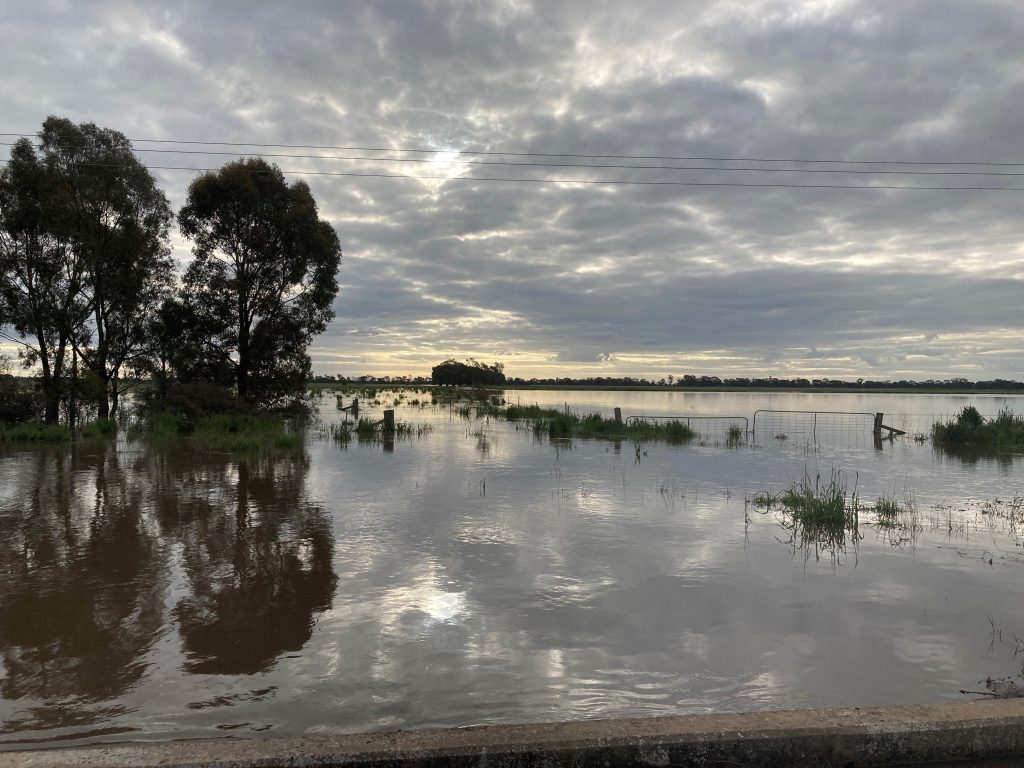
Natalie Egleton, CEO of FRRR, said that the Foundation has already seen local people and organisations once again step up and come together to support one another in the lead up and, as waters start to recede in some places, with the long road to recovery that they have ahead of them.
“The people and places in flood affected regions throughout Victoria, New South Wales and Tasmania will continue to feel the impacts of what’s unfolding for months and years to come. We really can’t stress enough just how big the long term social and economic consequences can be as a result of these kinds of natural disasters.
“Many of these regions, particularly those in Central Victoria, have been through this kind of disaster before, making the current floods all the more traumatic. Many members of the FRRR team themselves have spent the last few days evacuating, helping loved ones to evacuate or have been out sandbagging in their local communities.
“In the last 20 plus years, FRRR has built strong networks and relationships with the people and the community organisations that are being impacted right now and, as always, we’ll be waiting and ready to support them throughout the medium to long term recovery process. Donations to our flood appeal will help to rebuild infrastructure in these areas, address the physical and mental health challenges that occur as a result of this disaster, build the capacity of community groups and strengthen community-led recovery efforts,” Ms Egleton explained.
People can support FRRR’s Flood Recovery Appeal by donating to the Disaster Resilience and Recovery Fund, the Central Victorian Fund or the Strengthening Rural Communities: Prepare & Recover program.
Donations to the Disaster Resilience and Recovery Fund are pooled and invested to ensure that remote, rural and regional communities affected by natural disasters can access flexible, fit-for-purpose funding to support local preparedness and recovery efforts, when it’s needed. For those specifically wanting to support Central Victoria, FRRR also offers the Central Victoria Fund, which continues the legacy of the Central Victoria Community Foundation and focuses solely on that region.
Alternatively, donations can be made to FRRR’s Strengthening Rural Communities: Prepare and Recover program, with FRRR offering one-off, flexible grants through this program to support community organisations in these flood-impacted regions.
FRRR has supported remote, rural and regional communities across the country prepare for and recover from natural disasters since 2006. To date, FRRR has distributed around $46 million for community-led disaster recovery and resilience initiatives.
If you’d like to provide immediate assistance, below is a list of some local organisations that are helping to coordinate support in affected areas:
- Tomorrow Today Foundation – Benalla
- Border Trust – Albury Wodonga Region Community Foundation
- Greater Shepparton Foundation
- Into Our Hands – North East Victoria
- Shepparton FoodShare
- Home – Bendigo Foodshare
- Neighbourhood Houses
- GIVIT
- Rural Aid
- Spontaneous Volunteering – Maribyrnong, Seymour, Rochester, Shepperton and Echuca
Finally, if you would like to volunteer, BlazeAid is currently in the process of recruiting and assembling crews of volunteers.
Nearly $750,000 committed but more needed
Nearly $750,000 has been committed to FRRR’s Flood Recovery Appeal, launched last week, thanks to generous contributions and promotion from donor partners including AMP Foundation, Frasers Property Foundation, Stockland CARE Foundation, Suncorp and Wilson Asset Management, as well as many other private and individual supporters.
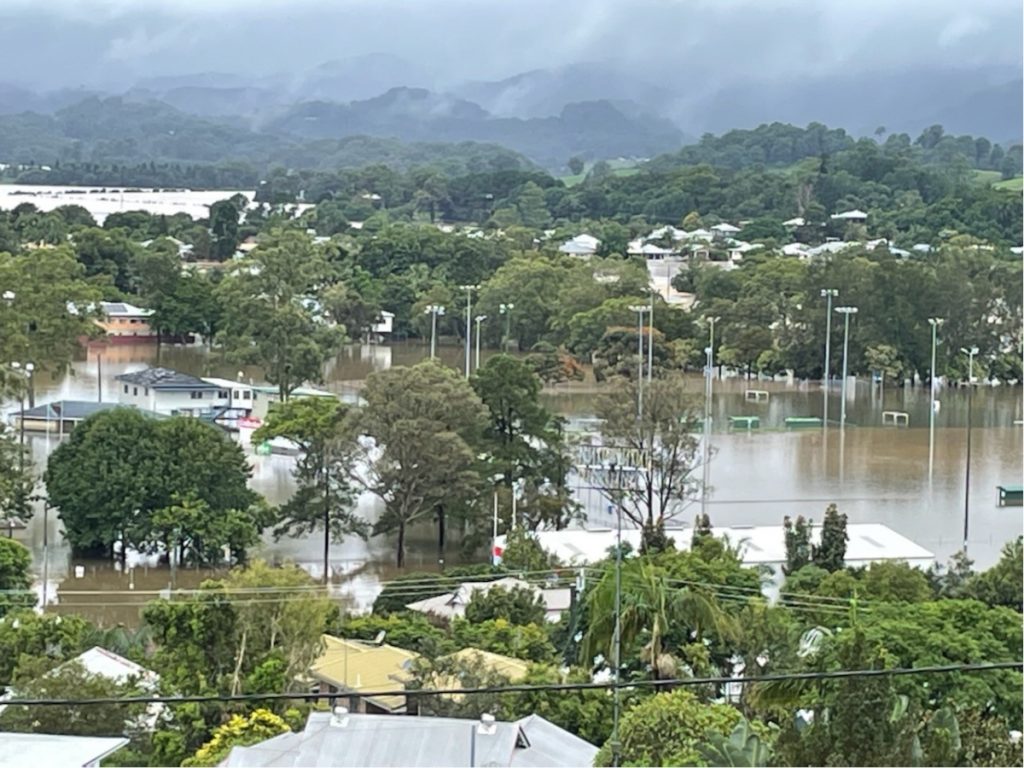
However, FRRR is continuing to seek further donations to meet the recovery needs of the growing number of communities outside metro regions that will require support well into the future. This includes the unfolding disaster in Queensland and New South Wales, as well as areas that have already experienced severe flooding.
Natalie Egleton, CEO of FRRR, said that the Foundation has already seen local people mobilising, with information being shared via community-based networks and, where waters are receding, local people are already looking ahead to what’s going to be needed.
“It’s hard to understate the impacts of these floods, which in many places follow years of drought, bushfires, COVID restrictions, and previous floods – and from which many are still recovering. The social and economic impact on many rural communities will be severe.
“Communities will have different concerns and needs, so recovery will happen at different rates, depending on the community and local priorities. Our focus is to make sure that once local leaders identify what their recovery needs are, there is support available.
“FRRR’s strong networks and relationships with community groups and not-for-profits in impacted areas, coupled with programs already in place, mean we will be ready to offer support when they are ready.
“Donations to our Flood Recovery Appeal will help to fund a diverse range of initiatives. That could be rebuilding infrastructure, supporting vulnerable community members, addressing the overall mental health of locals, providing opportunities for locals to reconnect and share their experiences, or improving resilience for future disasters,” Ms Egleton explained.
People can support FRRR’s Flood Recovery Appeal by donating to either the Disaster Resilience and Recovery Fund or the Strengthening Rural Communities program.
Donations to the Disaster Resilience and Recovery Fund are pooled and invested to ensure that remote, rural and regional communities affected by natural disasters can access flexible, fit-for-purpose funding to support local preparedness and recovery efforts, when it’s needed.
Alternatively, donations can be made to FRRR’s Strengthening Rural Communities program, with FRRR making grants to support community organisations in these flood-impacted regions.
FRRR has supported remote, rural and regional communities across the country prepare for and recover from natural disasters since 2006. To date, FRRR has distributed more than $40 million for community-led disaster recovery and resilience initiatives, including more than $7 million for projects supporting recovery from the 2019-20 bushfires.
To donate to FRRR’s Flood Recovery Appeal visit – https://frrr.org.au/giving/flood-recovery-appeal/
Much needed boost for 17 initiatives in affected NSW and QLD rural communities
FRRR, in partnership with Suncorp Group, has awarded $200,000 in grants to 17 community groups and local not-for-profits in rural areas impacted by the March 2021 floods and storms for initiatives that will support their recovery from the disaster.
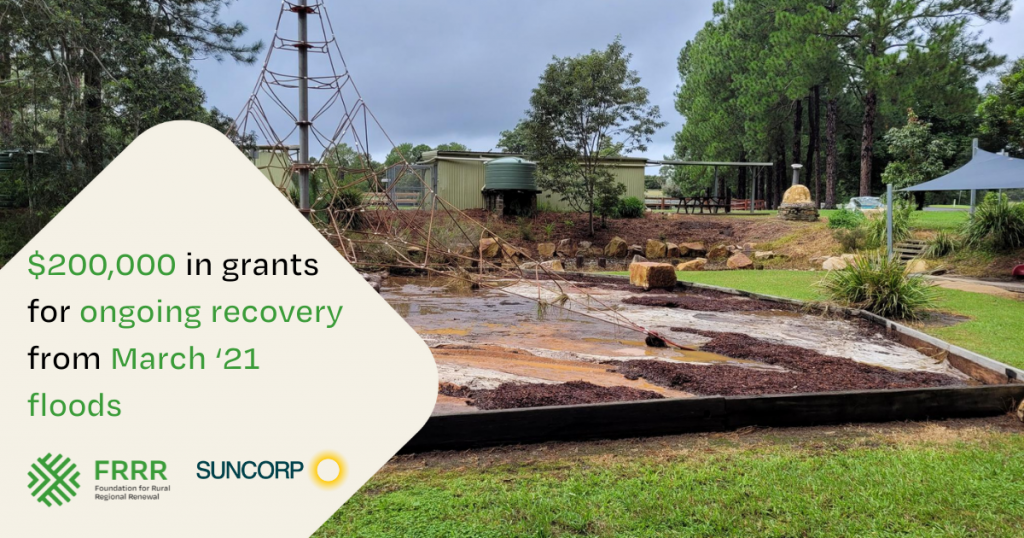
Funded through the Rebuilding Futures program, grants awarded range from $1,573 to $15,000. This funding will help with projects such as restoring damaged infrastructure, improving buildings and maintaining equipment needed for future disaster events, developing local disaster-response knowledge and skills, and providing access to services that foster recovery.
These grants are the first to come from Suncorp Group’s $1 million pledge to FRRR to support rural Australian communities impacted by, or vulnerable to, significant natural disasters.
Natalie Egleton, CEO of FRRR, said the grant recipients have showed a sense of resolve and strength when it comes to rebuilding.
“Recovery is not a quick process – not every community is going to have the capacity to take the same steps at the same time. Despite this, and the challenges of COVID-19 and volunteer fatigue, we’ve been genuinely impressed by the drive of local groups to actively seek support and funding to help their communities recover from the floods. It’s this kind of resilient spirit and motivation that will see these communities thrive once again.
“More than 50 percent of the applications we received for this round were for infrastructure and equipment, which shows not only the extent of the physical damage from the flooding, but also the long-term approach that these organisations are taking to the rebuilding of their communities,” said Ms Egleton.
Suncorp Group CEO, Steve Johnston, said these grants will enable recipients to overcome challenges and take control of their futures.
“The recipients of these grants are determined to make sure their communities recover and bounce back from the March 2021 floods. Natural disasters can turn people’s lives upside down, but the challenge has become even greater with the added pressure of the pandemic.
“Our remote, rural and regional communities know how to come together and work to rebuild their own futures. That’s why grant programs like these, that champion community-led recovery, are so crucial,” said Mr Johnston.
Among the 17 projects funded this round are:
- Bumbalong Valley Progress Association, NSW – Bumbalong Emu Project – $12,490 – Boost community connection and support the conservation of the local emu population by replacing infrastructure damaged during the March 2021 floods.
- Hawkesbury City Council, NSW – Hawkesbury Community Tech Connect – $14,836 – Enhance access to internet and mobile phone coverage with the creation of community technology hubs across the Hawkesbury region reducing isolation and supporting disaster recovery activities.
- Weemelah Hall, NSW – Beautification and Infrastructure Upgrade Project – $13,358 – Enhance community spaces with the installation of a BBQ for community use and beautification of the Weemelah Hall.
- Rathdowney and District Memorial Grounds Association Incorporated, QLD – Repair Rain-damaged Equestrian Arena and Make it Flood-resistant – $15,000 – Upgrade community infrastructure to mitigate the impacts of future flood events on the Rathdowney Memorial Ground.
More information on the Suncorp Rebuilding Futures grant program is available here.
The full list of grant recipients and their projects are below.
| Organisation | Project | Location | Grant | |||
|---|---|---|---|---|---|---|
| NEW SOUTH WALES | ||||||
| Bermagui Area Chamber of Commerce & Tourism Inc | A Positive Future Grow the organisations capacity to support the community with the provision of a portable projector and screen to enhance the delivery of community activities and events. | Bermagui | $2,584 | |||
| Bumbalong Valley Progress Association | Bumbalong Emu Project Boost community connection and support the conservation of the local emu population by replacing infrastructure damaged during the March 2021 floods. | Bumbalong | $12,490 | |||
| Hawkesbury City Council | Hawkesbury Community Tech Connect Enhance access to internet and mobile phone coverage with the creation of community technology hubs across the Hawkesbury region reducing isolation and supporting disaster recovery activities. | Bilpin, Colo & St Albans | $14,836 | |||
| Huskisson Public School Parents and Citizens Association | Huskisson Public School Community Canteen Boost community resilience and connection with upgrades at the Huskisson School canteen, providing appropriate cooking facilities for the community to cook, prepare and share meals. | Huskisson | $10,000 | |||
| Kempsey Singers Incorporated | Kempsey's Bandbox Theatre Costume Conservation Project Boost organisational capacity by repairing and mitigating future flood impacts at the Bandbox theatre and replace a portion of costumes damaged by the March 2021 floods. | Kempsey | $5,000 | |||
| Kendall Men's Shed | Noise Level Reduction Boost the service offerings at the Kendall Men's Shed with noise reducing machinery encouraging community participation and connection. | Kendall | $1,573 | |||
| Make a Difference PMQ Incorporated | MAD SHED Boost the organisations capacity to support their community, particularly through recovery with the provision of a shed to house essential equipment and machinery. | Port Macquarie | $15,000 | |||
| Mission Australia | The Common Approach - A Whole of Community Response to Child and Youth Wellbeing Grow community connection and wellbeing by providing activities through "The Common Approach" as a whole of community response to child and youth wellbeing across the Mid Coast region. | Taree | $10,811 | |||
| Unkya Reserve Committee of Management Nambucca Valley Council | Stay and Play - Unkya Reserve Playground Flood-Resilient Upgrade Boost access to family oriented community spaces with the repair of stairs and the installation of picnic table, bench and shade at the Unkya Reserve. | Eungai Creek | $15,000 | |||
| Quambone Resources Committee Inc | Quambone Memorial Hall - Final Touches Boost community connection by providing enhancements to the Quambone Memorial Hall, ensuring access to a comfortably appointed community facility for all to enjoy. | Quambone | $12,500 | |||
| River Cares Incorporated | To Improve Emergency Preparedness and Resilience by Developing a Community Emergency Plan Support emergency preparedness for Spencer and surrounding areas with the development of the Spencer Community Emergency Response Plan. | Spencer | $14,832 | |||
| UCA - Lifeline North Coast (NSW) | Psychological First Aid Workers - First Response Volunteers Strengthen community members mental health and wellbeing and assist in the training of community volunteer in Mental Health First Aid to support local recovery and resilience building. | Coffs Harbour | $14,800 | |||
| Upper Macleay Pre-School Incorporated | Tranquil and Safe - Upper Macleay Preschool Flood Recovery Initiative Support flooding preparedness by enhancing the Upper Macleay Preschool with repairs to flood damaged infrastructure and better preparing for future flooding events. | Willawarrin | $12,487 | |||
| Weemelah Hall | Beautification and Infrastructure Upgrade Project Enhance community spaces with the installation of a BBQ for community use and beautification of the Weemalah Hall. | Weemelah | $13,358 | |||
| Young Men's Christian Association of Sydney | The Y NSW CoastTeen Project - Empowering Peer-to-Peer Mental Health Support for Young People Living on the Central Coast Support community wellbeing with the delivery on the Youth Mental Health Peer Support program in the NSW Central Coast region. | Lake Haven | $14,729 | |||
| QUEENSLAND | ||||||
| Rathdowney and District Memorial Grounds Association Incorporated | Repair Rain-Damaged Equestrian Arena and Make it Flood Resistant Support the mitigation of impacts of future flood events on the Rathdowney Memorial Grounds by repairing, leveling and compacting the sand arena damaged during the March 2021 floods. | Rathdowney | $15,000 | |||
| Tamborine Mountain A H & I Society Inc | Replacement of Safety Rails on Access Ramp Increase accessibility to the Tamborine Mountains Showgrounds Pavilion by replacing the handrails and the front of the pavilion. | Tamborine Mountain | $15,000 | |||
By Natalie Egleton, CEO
Over the past month, I’ve had dozens of conversations with community leaders, local, state and commonwealth governments, philanthropic foundations, and corporate partners, that have all circled around the question of disaster resilience and best practice giving. I’m encouraged by the growing sentiment that recognises the increasing frequency and severity of disasters, yet also see a pressing need to shift our approaches to funding disasters as one-off events.
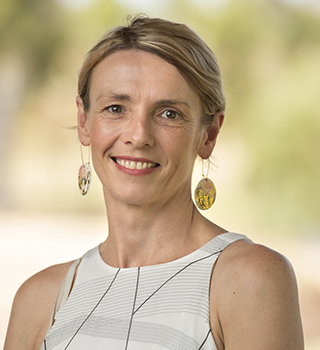
The floods that have devastated so many areas across NSW and parts of Queensland this month are yet another in a series of disasters that rural communities have had to face in the past year. Many of those communities have experienced prolonged drought, bushfires, minor flooding, and now catastrophic flooding. For these communities, the rebuild, recovery, and long-term renewal will call on yet more reserves of social capital. Support will be needed that doesn’t compartmentalise their various disaster impacts and which acknowledges the deeply fatiguing and depleting effects of successive disasters on people, communities, and local service systems.
At FRRR, we view disasters as environmental shocks that remote, rural, regional communities regularly experience. We know they are inevitable and increasing in frequency and severity; what makes them complex is not knowing when they will occur, where, or the severity and nature of their impact.
Recovery and preparedness are only as strong as the social ties, quality of community infrastructure, depth and breadth of skills and networks, cultural knowledge, and the health of local service systems, non-profits, and community groups.
That’s why investing in social capital – preparing for future disasters and adapting to changing conditions after a disaster – underpin our ongoing work outside of disasters. Mitigation and making advances through technology is vital, but only effective when people within communities – those who will act first and drive recovery and preparedness – are invested in.
Our approach is to provide support where there are gaps or quick responses are needed in the short term, however we focus the majority of funds on the medium-to-long term recovery and future preparedness efforts of rural communities. Funding medium to long-term recovery ensures that resources are available to help communities when they are ready, beyond their immediate needs that arise during the emergency.
Adapting and evolving
In operational terms, FRRR has a standing disaster philanthropy model that we scale when a major disaster occurs. Each year, with support from hundreds of donor partners, we provide grants and capacity support to around 500 hundred remote, rural and regional communities across the country via almost 800 grants. This reach gives us a good footprint and connection points that we can naturally tap into when disasters occur.
Right now, we have almost 1,500 active grants in place for diverse projects in remote, rural, regional communities nationally; around 40% of these are supporting community-led recovery and resilience initiatives.
When the 2019-20 bushfires hit FRRR had to scale our processes very quickly. We expanded existing grants programs that have a national footprint, as well as brokered funds management for corporate partners to support short-term recovery.
In the space of a month, FRRR went from having about 700 donors to 30,000 donors. We had to ensure our systems could cope and we needed to scale up our communications and finance management resourcing. At the same time, we were engaging in working groups and forums with Governments, philanthropy, and connecting with fire-affected communities where we had active grants and relationships.
When COVID-19 hit, our biggest challenge, aside from looking after our people, was adjusting our community engagement approaches.
While regional Australia is great at working remotely, working on recovery, trying to engage with largely volunteer-led community groups and not-for-profits is really done best in person.
Understanding the local context can be done remotely but it’s not ideal. We also found that as restrictions came into place, a lot of community groups went to ground.
We knew there would be significant impacts from COVID-19 on recovery from the 2019-20 bushfires because the lockdowns would essentially stall social recovery processes, which are most effective when people come together physically, to process and heal.
One of our big, but unsurprising observations during COVID was the gaping hole in digital inclusion – equitable access to stable telecommunications, low levels of digital connectivity in households, and low digital literacy in what are largely ageing populations. In the Snowy Valleys for example, we learnt that 24% of people didn’t have an internet connection at home. In Tasmania, connectivity is inconsistent and communities very isolated.
At the same time, we were seeing independent news publications falling over and rural communities were becoming even more isolated.
The shocks and disruptions just kept coming and the readiness wasn’t there. And then, large parts of NSW were impacted by once-in-a-century floods.
We hear a lot about needing to increase resilience and I am of the firm view that that is coming from the wrong angle. There is an abundance of resilience, but only so much that any strong community can absorb and bounce forward from.
Embedding disasters in regional development practice
The past year has proven the repeated warnings of many. The frequency and severity of natural disasters will cost society, economies, biodiversity, and liveability. We need to do things differently.
In our work partnering with a community in NSW focussing on their non-profit sector capacity building before the 2019/20 bushfires, it was clear that those organisations and community leaders were more ready to respond to the recovery process and opportunities it presented. These same communities are now facing an unimaginable clean up and recovery from flooding. Our role is to be there, offer patience, continuity, flexibility, and agility to move how and when the community is ready with fit-for-purpose funding and resourcing support. The critical piece here is that when we do this work between disasters, reserves of social capital can be replenished and expanded. Communities are more able to engage with mitigation and do essential future-focussed work to strengthen their response to risk and climate change.
Innovation and renewal – applying learnings to support flood-impacted communities
Since the bushfires, we have reviewed and adjusted our approach to funding the core operating costs of the community groups that are so essential to the fabric and vitality of remote, rural and regional communities.
With the funding model of our national small grants programs being relatively unpredictable and dependent on donations from our partners, it is difficult for FRRR to commit to resourcing beyond one-off grants that seed and strengthen locally led projects.
However, throughout the pandemic, the FRRR Board recognised that the depletion of fundraising revenue, volunteer capacity, and local sponsorships, coupled with increased vulnerability and successive disasters, presents a serious threat to the survival of community groups and local not-for-profits. We recognise this as being critical at this point in time, so we will support core overhead costs until the picture changes. It will still be one-off funding but will help to keep the lights on and people working on key issues, while communities and organisations adapt and evolve through the recovery.
This approach translates to better practice for disaster philanthropy overall.
Given what is unfolding in NSW and Queensland at the moment, it is time that we stop looking at disasters as one-off events and view disasters as a constant. This means that we need to invest in underlying capacity and capability at the community level.
The new National Resilience, Relief & Recovery Agency, along with several State Agencies, are now modelled through an all-hazards lens and hopefully the policy and funding settings will follow. Philanthropy can then play a meaningful role beyond responding to successive crises.
It’s certainly where we are focussing more and more of our efforts, and we welcome more conversation on this.

